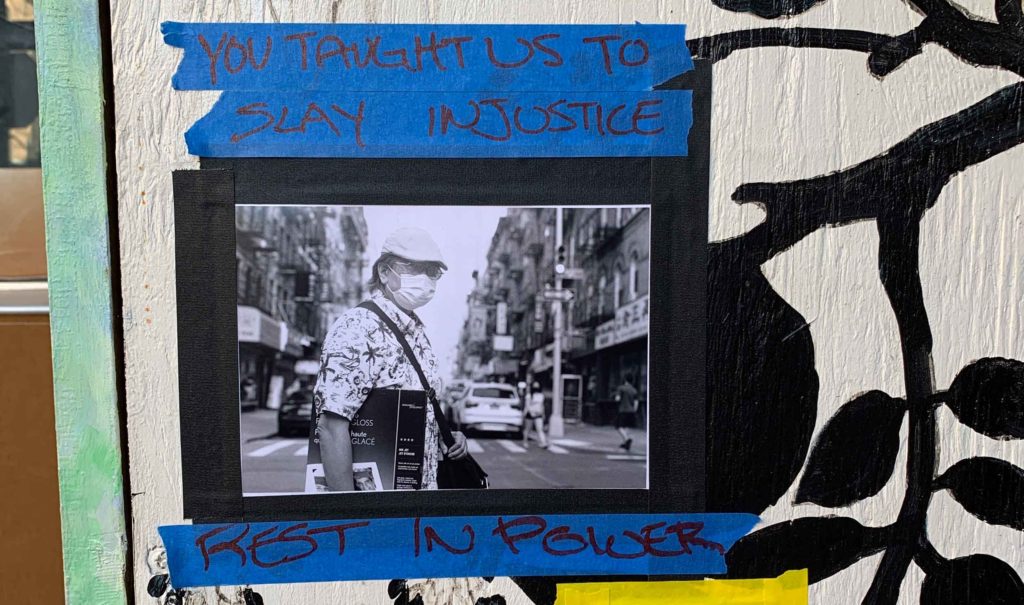
Photo by Antony Wong
“Every time I take my camera out of my bag, it is like drawing a sword to combat indifference, injustice and discrimination and trying to get rid of stereotypes.”
AAARI Videos Featuring Corky Lee
May 9, 2003
Thirty Years of Asia America:
Images by Corky Lee
September 28, 2010
Photography as Primary & Secondary Data
June 2, 2011
Into East River(s): Chinese / American Artists
and Asian American Poets
April 25, 2012
Putting Asian Americans on the Map:
The Politics of Redistricting in New York City
News Articles
January 29, 2021
Corky Lee, Who Photographed
Asian-American Life, Dies at 73
https://nyti.ms/2YTzMUZ
January 30, 2021
Corky Lee’s Photographs Helped Generations
of Asian-Americans See Themselves
https://bit.ly/3rmDfHs
February 2, 2021
How Corky Lee’s legacy goes far beyond
photography
https://nbcnews.to/36EmyiU

https://youtu.be/golC2fEWYoo
The QView #92 (February 9, 2021)
A friend of mine, Corky Lee, a Queens College alumnus, passed away last month from COVID-19. A “Queens kid,” Corky was famous as a photographer who used images to advance activism. He noticed how Asian Americans were almost always left out of the picture, literally. As a child of Chinese immigrants, he set out to change that. He became known as the unofficial photographer of everything Asian American, appearing at any community event, big or small.
One of his passion projects was about the transcontinental railroad. Finished at Promontory Point, Utah, in 1869 with a “Golden Spike” ceremony that brought together the nation as never before, the western half of the massive infrastructure project was built by about 15,000 Chinese laborers. Yet the ceremonial photos, among the most famous pictures of the era, showed not a single Chinese face—despite their effort, they were erased. With their descendants, some sixth-generation Americans, Corky restaged the celebration with an annual pilgrimage, becoming official at the 150th anniversary commemoration. Other photographers were there to document the festivities, but all eyes were on Corky. In recognizing his passing, I want to acknowledge the over 400,000 Americans who have succumbed to the pandemic so far and the many more who are suffering still.
—Frank H. Wu, President, Queens College/CUNY
Association for Asian American Studies Newsletter (February 9, 2021)
Corky Lee did everything that we aspire to do in the field of Asian American Studies, including documentation, scholarship, teaching, community service, and advocacy. A veritable “Where’s Waldo” figure who was ubiquitous in New York City’s Chinatown for five decades, he eventually became a fixture at AAAS Annual Conferences as well as exhibitions, parades, hearings, classrooms, festivals and any place where APA history was being made.
Corky passed away on January 27 at the age of seventy-three from Covid-related issues in NYC, but the gifts he shared with us as a professional group and as a individuals will always be with us. If you google his name, you will see him speaking about 19th century Chinese American railroad workers in Seattle, exhibiting photos on APA activism in Colorado, lobbying Congress to push for the Congressional Medal of Honor for Chinese American World War II Veterans, and helping AALDEF as an expert witness on Chinese typography so that the first Chinese language ballots would be authorized in NYC under the Voting Rights Act.
In short, Corky was an outstanding photographer, documenting everyone from elected officials to the waiters in a small family restaurant to a crowd of demonstrators advocating for justice. However, he also used his knowledge of history and his commitment to justice to point his lens in a way that captured what was as well as what should be. His photo of a Sikh American man with a turban and an American flag draped around his shoulders after the 911 attacks is a reminder that irrational anti-Muslim and xenophobic forces were alive, an affirmation of the humanity of the Sikh American community, and a commitment to do whatever was necessary to protect the Sikhs in the uncertain days that followed.
As scholars, teachers, and activists committed to a field born of 1960s movements for racial justice and student activism, we can best honor Corky’s memory by re-dedicating ourselves to the thing he did best – building a more just, peaceful and fascinating world, one person and one day at a time.
—Phil Tajitsu Nash, Asian American Studies Program, University of Maryland
